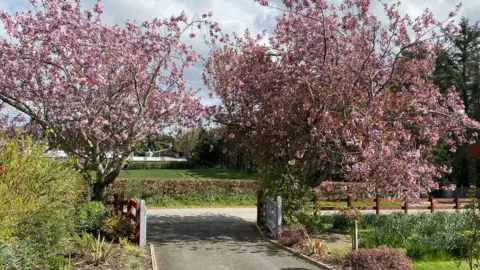Hay fever: How to enjoy time in the garden during the summer
 Getty Images
Getty ImagesLet's pretend that it's the weekend and I'm forecasting warm, dry sunny weather with a gentle breeze.
This may sound like great news. Everyone's smiling and planning time in the garden, with maybe a barbecue or a walk in the countryside planned.
Well, for approximately 20% of the population, it is not great news.
People who suffer from pollen-related allergies, such as hay fever, may have to resign themselves to a weekend spent indoors.
And the hay fever season has arrived.
Tree pollen is the current culprit, primarily Birch and Ash trees.

How does pollen affect us?
The pollen is absorbed into the nasal passage, eyes or mouth.
This causes the immune system to produce chemicals called histamines, which can then cause inflammation and itching.
Antihistamines and steroids are often prescribed to reduce this process.
Debbie has been a pharmacist for over 10 years and suffers from hay fever herself.
She said pharmacists tend to see an increase in people coming into the chemist from April, with bouts of sneezing, sniffing, coughing and wheezing.
But it can start much earlier if March has been warm and dry.
 Desmond Kelly
Desmond KellyPeople can develop hay fever at any stage of their life, and they can also outgrow it.
It belongs to the same family as asthma and eczema, so people with a genetic link to either of these may be more predisposed to getting hay fever.
In some cases, sufferers may not be able to dry clothes outdoors as the pollen can get trapped in the material.
Sufferers may also have to wear wrap-around sunglasses to stop the pollen getting near the eyes, and apply Vaseline around the nostrils to create a barrier to stop the pollen entering the nose.
Pollen can also get trapped in someone's hair or a pet's fur.

Does this mean no time in the garden?
Olivia Kirk is an experienced landscape and garden designer who specialises in creating healing gardens.
She said it is totally possible to have a pretty, colourful garden that is low in allergens.
Pollen levels appear to have risen all of a sudden because the recent cold, wet weather suppressed the early pollen, she suspects.
Very few places have experienced 20C (67F) across the UK and Ireland, and May is the last month of Meteorological spring.
But now that it is warming up, everything is starting to bloom at the same time - which could lead to a double whammy of pollen in the air.
Tree pollen, which is what we currently have, is very light and is easily carried by the wind.
It is very small and is attracted to the eyes, nose and mouth, but cold, wet weather will deter this.
In general, pollen production can be more significant in a warm and wet spring, and early summer.
This would then need to be released in breezy and dry conditions to create the most significant impacts.
 Tommy Ashe
Tommy AsheFlowers pollinated by insects is heavier and stickier so does not travel as easily, and thus tends to fall on the ground.
Male pollen is the problem, and yes, there are male and female versions of many trees and plants.
Female trees produce fruit and nuts after they flower and drop them on the ground.
But male trees do not drop, and for some gardeners, are deemed to be tidier.
But they are building the allergens which are then dispersed in the air along with other pollutants.
Later in the year, we have grass pollen which typically lasts from mid-May until July.
Weed pollen then becomes more prevalent and takes us into early autumn.
But Ms Kirk said the season has now widened and this is, in part, down to our warming climate.
Cutting grass later into the autumn also extends the hay fever season as the majority of sufferers are allergic to grass pollen.
So a mild spring, warm dry summer and a mild autumn is not good news for those.

What does a hay fever friendly garden look like?
The advice is to plant fruit trees and flowers that bees like.
Trees such as pear, apple and cherry blossom are fine as well as roses, tubular flowers such as daffodils, foxgloves, tulips and most dahlias.
Pollen forecasts are now available from the UK Met Office and Met Éireann in conjunction with the University of Worcester (NPARU).
 Louisey
LouiseyWhen is the best time to go outdoors with hay fever?
The first thing to do is identify the type of pollen you are allergic to and then monitor the pollen forecasts.
If it is high, pollen levels tend to peak at the start and end of the day.
On a warm day the pollen can be carried high into the atmosphere before it drops down to lower levels as temperatures drop in the evening.
So the middle of the day might be the best time to go outdoors, depending on your sensitivity.
